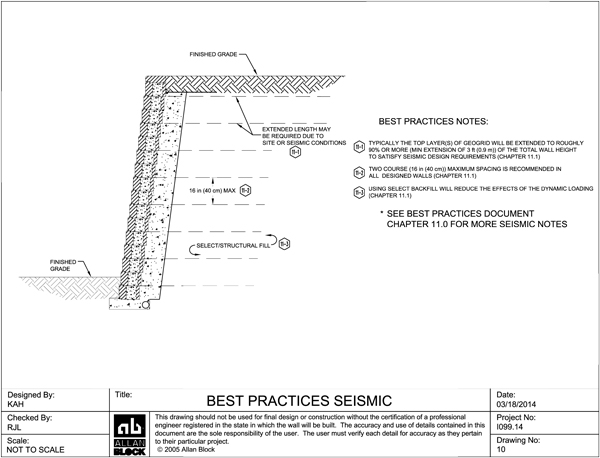Chapter 11: Seismic Considerations
Click on the topics below to view more information on the best practices for Allan Block segmental retaining wall design for residental and commercial applications.

11.1 For walls with dynamic loading:
- Designer must understand the local seismic code requirements before starting design.
- Closer spacing of geogrid is recommended, maximum 16 in (40 cm).
- Extension of the top layers of geogrid. Typically the top layers will be extended to roughly 90% or more of the wall height to satisfy design requirements.
- Using select/structural backfill will reduce the effects of the dynamic loading.
- For more information on seismic design and the effects on segmental retaining walls, see the Allan Block Executive Summary of the independent full-scale seismic testing conducted by Columbia University and the National Research Institute of Japan.
11.2 When dealing with a slope above a wall with seismic loading applied to the wall, the same acceleration coefficient applied to the wall must also be applied to the stability calculations of the slope.
11.3 The Mononobe-Okabe (M-O) seismic methodology places limits on the steepness of any slope above the wall. If during the design phase it is determined that the desired slope is not allowed, the site grading should be altered or the wall height should be increased to reduce the steepness of the slope above. See section 12.4 for description of slope steepness.
11.4 While the M-O method is the standard used in the seismic design of segmental retaining wall, a trial wedge method may be utilized to investigate walls when the M-O method becomes limited due to slopes above. Using methods similar to a global stability model the trial wedge method determines the weight of the soil wedge above the failure plan and determines the active earth pressure of the soil wedge acting at the back of the soil mass. Using the trial wedge method is not without limitations as well. The solution it provides is purely mathematical and understanding soil mechanics and the slope steepness limits is also important. The limitation to the steepness of a slope discussed in section 12.4 still apply, and if the designer chooses to utilize the trial wedge method for walls with slopes above that exceeded the soil mechanic limits, they must review the slope stability in a global stability program and possibly reinforce the slope above the wall. For a greater discussion on the Trial wedge method see Chapter 5, Seismic Design, in the Allan Block Engineering Manual.

